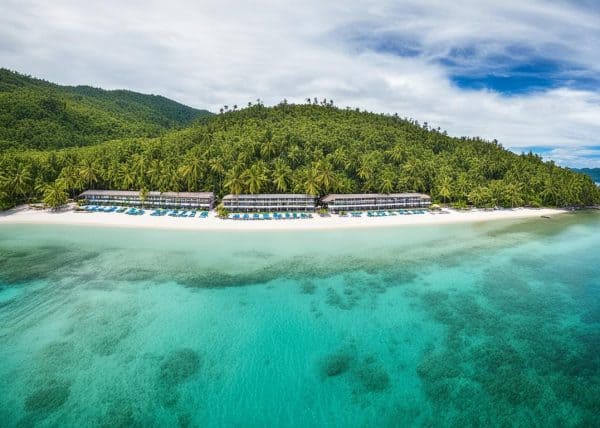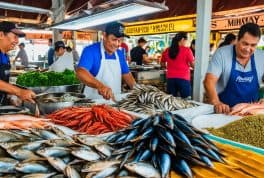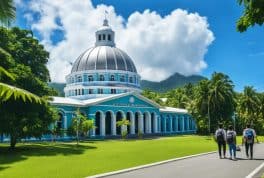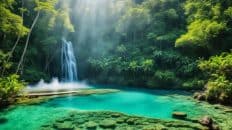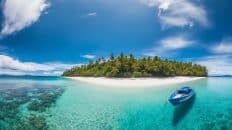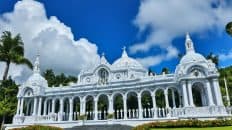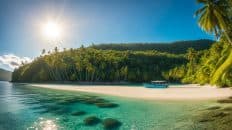Leyte Island
Leyte, in the Philippines' Eastern Visayas region, is renowned for its historical significance, notably in World War II with the Leyte Gulf landing. This picturesque island features diverse landscapes, from tranquil Lake Danao to the impressive San Juanico Bridge. Celebrated for vibrant festivals and unique cuisine, Leyte's rich cultural heritage and natural beauty make it a unique and captivating destination.
Top 10 Things to see in Leyte
- MacArthur Landing Memorial National Park - Located in Palo, this historical park commemorates the landing of General Douglas MacArthur and Allied Forces during World War II. It's a significant site for understanding the history of the Philippines during the war.
- San Juanico Bridge - Known as the longest bridge in the Philippines, it offers a breathtaking view of the San Juanico Strait. The bridge itself is an architectural marvel and a symbol of connection between the islands of Leyte and Samar.
- Lake Danao National Park - A guitar-shaped lake surrounded by lush hills, it's a perfect spot for nature lovers. Activities include kayaking, paddle boating, and enjoying the serene natural scenery.
- Sogod Bay - Ideal for diving enthusiasts, Sogod Bay is known for its clear waters and diverse marine life, including the chance to see whale sharks.
- Leyte Provincial Capitol - Located in Tacloban City, this historic building is a fine example of American colonial architecture and holds historical significance as a seat of the provincial government.
- Sto. Niño Shrine and Heritage Museum - This museum in Tacloban City is part of the legacy of former Philippine President Ferdinand Marcos. It showcases a mix of historical items, artifacts, and elaborate architecture.
- Palo Cathedral - Also known as the Metropolitan Cathedral of Our Lord’s Transfiguration, this historic church is an important religious site and a testament to the province's rich religious heritage.
- Cuatro Islas - A group of four beautiful islands off the coast of Leyte, known for their pristine beaches, clear waters, and abundant marine life. These islands are perfect for snorkeling, swimming, and relaxation.
- Tangkaan Beach - Located in Padre Burgos, this beach is famous for its white sandy shores and crystal-clear waters, offering a tranquil escape and excellent snorkeling opportunities.
- Leyte Landing Memorial Park in Red Beach - This park, situated in the municipality of Palo, marks the actual spot of the Leyte Landing. It's not only a place of historical importance but also offers a scenic beachfront and a peaceful environment for visitors.
Guides and Tours
Cities on Leyte
- Tacloban City
- Ormoc City
- Baybay City
- Maasin City
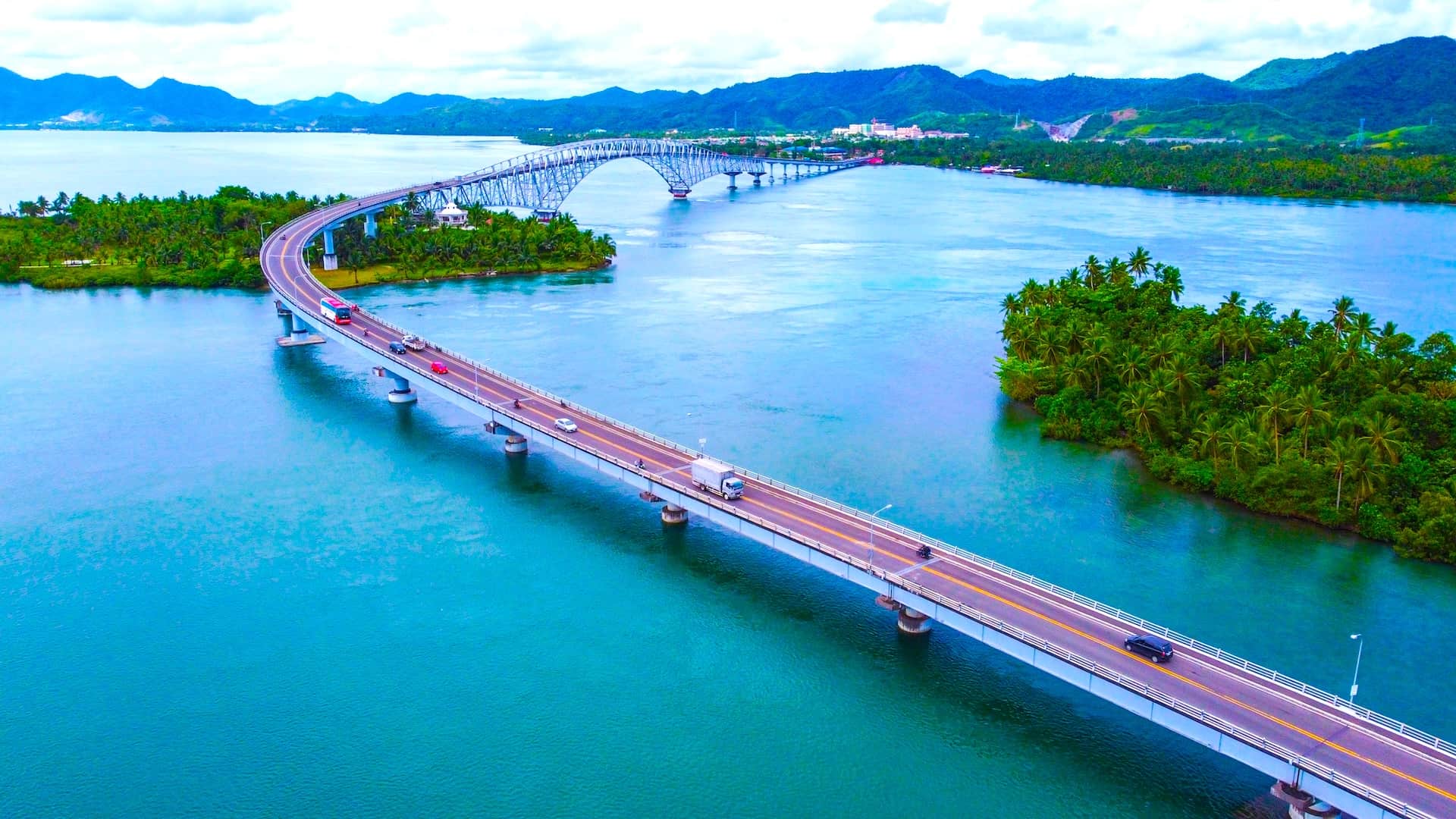
Top 10 Questions and Answers about Leyte
1. What is Leyte Island known for?
- Answer: Leyte Island is renowned for its significant role in World War II, particularly the Battle of Leyte Gulf, one of the largest naval battles in history, and the Leyte Landing, where General Douglas MacArthur fulfilled his promise to return to the Philippines. The island is also known for its rich cultural heritage, natural beauty, including Lake Danao and San Juanico Bridge, the longest bridge in the Philippines.
2. Where is Leyte Island located?
- Answer: Leyte Island is located in the Eastern Visayas region of the Philippines. It is situated in the central part of the country, bounded by the Camotes Sea to the west and the Philippine Sea to the east.
3. What are the major cities in Leyte?
- Answer: The major cities in Leyte include Tacloban City, the provincial capital and a highly urbanized city, and Ormoc City, known for its sugar industry and beautiful landscapes. Both cities play significant roles in the region’s economy and culture.
4. What is the climate like on Leyte Island?
- Answer: Leyte Island has a tropical climate, characterized by a relatively hot and humid atmosphere. The island experiences a wet season and a dry season, with the wet season typically occurring from June to December, bringing in significant rainfall.
5. What is the cultural heritage of Leyte Island?
- Answer: Leyte Island’s cultural heritage is diverse, influenced by indigenous traditions and Spanish colonial history. The island is home to the Waray-Waray people, known for their vibrant festivals, such as the Pintados-Kasadyaan Festival, and their distinct language, which is part of the Visayan language family.
6. What are some popular tourist attractions in Leyte?
- Answer: Popular tourist attractions in Leyte include the MacArthur Landing Memorial Park in Palo, Lake Danao National Park, the picturesque San Juanico Bridge, and various beautiful beaches, particularly in Southern Leyte. The island also offers historical tours, eco-tourism, and cultural experiences.
7. How did Leyte Island play a role in World War II?
- Answer: Leyte played a crucial role in World War II, particularly during the Battle of Leyte Gulf in 1944, which was a decisive Allied victory against Japanese forces. Additionally, the Leyte Landing marked the beginning of the liberation of the Philippines from Japanese occupation.
8. What is the economy of Leyte Island like?
- Answer: Leyte’s economy is diversified, with a strong base in agriculture, particularly rice and coconut farming, fishing, and an emerging focus on tourism and industry. The cities of Tacloban and Ormoc are key economic centers with growing business and trade activities.
9. What are the educational facilities available in Leyte?
- Answer: Leyte is home to several educational institutions, including Leyte Normal University in Tacloban City, offering various academic programs. The island has a range of public and private schools providing basic to higher education.
10. What are the environmental conservation efforts in Leyte?
- Answer: Leyte has undertaken various environmental conservation efforts, including reforestation projects, wildlife habitat protection, and eco-tourism initiatives. Programs to protect marine ecosystems and efforts to promote sustainable agricultural practices are also in place to preserve Leyte’s natural environment.

Why you should Visit Leyte
Discovering Leyte Island: A Journey Through History, Nature, and Culture
Introduction: The Alluring Charm of Leyte Island Leyte Island in the Eastern Visayas region of the Philippines is a destination that offers an enriching blend of history, natural beauty, and cultural vibrancy. Known for its significant role in World War II and its picturesque landscapes, Leyte provides a unique travel experience that captivates the heart of every visitor. This comprehensive review explores the multifaceted allure of Leyte, showcasing why it's a must-visit location.
Historical Significance: A Portal to the Past Leyte is a living museum, steeped in historical significance. The most iconic landmark is the MacArthur Landing Memorial Park in Palo. This site, where General Douglas MacArthur fulfilled his promise to return, is more than a monument; it's a testament to resilience and heroism. Walking through this park, one can almost hear the echoes of the past, offering a profound connection to history.
The Leyte Provincial Capitol in Tacloban City, with its American colonial architecture, speaks volumes of the island's historical journey. A visit here is not just a step back in time; it's an educational experience that enriches one's understanding of Leyte's role in shaping the nation's history.
Natural Wonders: Leyte's Breathtaking Landscapes Leyte's natural beauty is unparalleled. The serene Lake Danao National Park, with its unique guitar shape, offers a peaceful escape into nature. The park's lush greenery, rich biodiversity, and tranquil waters are ideal for kayaking, bird watching, and picnicking, making it a perfect spot for nature enthusiasts.
For beach lovers, Leyte doesn't disappoint. The pristine beaches of Southern Leyte, with their crystal-clear waters and white sandy shores, are a haven for relaxation and water activities. Sogod Bay, in particular, is a snorkeling and diving paradise, boasting vibrant marine life, including the magnificent whale sharks.
Cultural Immersion: Experience Leyte's Rich Traditions Leyte's cultural heritage is a vibrant tapestry that reflects its diverse history and traditions. The Pintados-Kasadyaan Festival is a colorful display of Leyte’s rich cultural heritage. Participating in this festival is not just about enjoyment; it’s an immersion into the soul of Leyte’s traditions.
The culinary experiences in Leyte are another highlight. Local dishes, influenced by the island's rich natural resources and history, offer a palate-pleasing journey. From the savory Binagol to the sweet Moron, Leyte’s cuisine is a delightful exploration of flavors.
Urban and Rural Balance: The Best of Both Worlds Tacloban City, the provincial capital, is a bustling urban center that offers modern amenities and a glimpse into Leyte's urban life. Here, visitors can enjoy shopping, dining, and entertainment options, along with historical sites like the Sto. Niño Shrine and Heritage Museum.
In contrast, Leyte's rural areas offer a serene and authentic experience. The agricultural landscapes, traditional villages, and friendly locals provide a peaceful retreat from the hustle and bustle of city life. These areas are ideal for those seeking a more laid-back and genuine interaction with local culture.
Environmental Initiatives: Leyte's Commitment to Sustainability Leyte’s efforts in environmental conservation are commendable. Initiatives to protect its natural landscapes and marine life speak volumes about the island's commitment to sustainability. Visiting Leyte’s eco-tourism spots, such as Cuatro Islas, supports these conservation efforts and provides an eco-friendly travel experience.
Connectivity and Accessibility: Ease of Travel The transportation infrastructure in Leyte, including the iconic San Juanico Bridge, facilitates easy travel across the island. The well-connected road network and local transportation options make exploring Leyte convenient and enjoyable. The accessibility of both urban and rural attractions ensures a comprehensive travel experience.
Accommodation and Hospitality: Leyte's Warm Welcome The range of accommodation options in Leyte caters to all preferences and budgets. From luxury resorts to budget-friendly homestays, the hospitality of Leyte is warm and welcoming. Staying in Leyte is not just about comfort; it's about experiencing the genuine warmth and friendliness of its people.
Conclusion: Leyte – A Destination That Captivates In conclusion, Leyte Island is a destination that truly captivates. Its blend of historical significance, natural beauty, cultural richness, and modern amenities makes it a unique travel destination. Whether you're a history buff, nature enthusiast, culture seeker, or just looking for a relaxing getaway, Leyte offers something for everyone. A trip to Leyte is more than just a vacation; it's an experience that enriches the soul, educates the mind, and creates lasting memories. So, pack your bags and set off on a journey to discover the enchanting island of Leyte – a gem in the heart of the Philippines.
Top 10 Hotels on Leyte
- Zpad Residences, Tacloban: Offers comfortable accommodation with good amenities. It is well-rated by guests for its value and service.
- iaLodge, Ormoc: Known for its accessibility and clean rooms, this hotel is a good choice for travelers looking for convenience in the city.
- Copenhagen Residences, Ormoc: This hotel provides excellent accommodations with high guest satisfaction ratings.
- RedDoorz @ Picas Sagkahan Tacloban: A budget-friendly option with decent facilities and services.
- Asia Novo Boutique Hotel - Ormoc: A hotel offering basic amenities at an affordable price, suitable for travelers on a budget.
- Jeamco Royal Hotel - Baybay: This hotel is appreciated for its reasonable pricing and satisfactory services.
- Summit Hotel Tacloban: Receives high praise for its accommodating staff and overall guest experience.
- Go Hotels Tacloban: Known for its clean rooms and excellent staff, this hotel is a favorite among travelers.
- The Oriental Leyte: Offers a luxurious experience with exceptional services, although some guests have noted issues with internet connectivity.
- Hotel XYZ, Tacloban: Highly rated for its smooth check-in process and accommodating staff.
Leyte Facts
1: Introduction to Leyte
Nestled in the heart of the Philippines, Leyte, a province that forms a significant part of Leyte Island, stands as a testament to the rich history, diverse culture, and breathtaking natural beauty that define this Southeast Asian nation. Leyte is not just a geographical entity; it is a tapestry of stories, struggles, and triumphs that have shaped the character of its people and the landscape of its land.
The island of Leyte, situated in the central Philippines, is a part of the Eastern Visayas region, which includes several provinces. Leyte itself is divided into two main areas: the larger Northern and Central sections and the smaller Southern Leyte. This division is more than just administrative; it reflects the varied topography, culture, and history of land area in the province. Leyte Island, with its rich and tumultuous history, stretches over an impressive land area, encompassing diverse landscapes from coastal plains to rugged mountainous regions.
The history of Leyte is deeply intertwined with the broader history of the Philippines. From the Spanish colonial era to the significant events of World War II, Leyte has been a witness to milestones that have shaped not just the archipelago but also the world. The most notable among these is the Battle of Leyte Gulf, a pivotal event in World War II. This battle marked a turning point in the war in the Pacific and is remembered globally for the bravery and sacrifice it entailed.
Leyte's capital, Tacloban City, is a highly urbanized city and serves as the administrative and commercial hub of the province. It is not just an urban center but a symbol of resilience and recovery, especially following the devastation wrought by Typhoon Haiyan in 2013. Tacloban, alongside Ormoc City, another major city in Leyte, plays a critical role in the economic and cultural landscape of the province.
The geography of Leyte is as diverse as its history. The whole island group is home to stunning natural attractions such as Lake Danao, a guitar-shaped lake situated in the Northern part of Leyte, and the San Juanico Strait, which separates Leyte from the neighboring island group of Samar. The San Juanico Bridge, an architectural marvel, spans this strait and is known as the longest bridge in the Philippines, connecting Leyte and Samar Islands. This bridge is not just a feat of engineering but a symbol of the connection between people and places in this region.
Leyte is also renowned for its natural beauty, with landscapes ranging from pristine beaches to lush mountains. Lake Danao National Park, a protected area, situated west of in north, offers a serene escape with its unique freshwater ecosystem and rich biodiversity. Southern Leyte, on the other hand, situated west of in south, boasts of beautiful coastlines and is a growing destination for beach lovers and divers.
In terms of demographics, Leyte reflects a diverse tapestry of Philippine society. The province, according to the Philippine Statistics Authority, has a significant total population, with a population density that varies across its urban and rural areas. The people of Leyte are predominantly Waray-Waray, speaking a language that is part of the Visayan language family, though Tagalog and Cebuano are also widely spoken. This linguistic diversity is a testament to the cultural melting pot that Leyte has become over centuries.
Economically, Leyte is a blend of agriculture and industry. The province is known for its main food crops like rice and coconut, and it also ventures into cash crops and fisheries. The presence of manganese deposits adds to the mineral wealth of the region. The economy of Leyte is also bolstered by its highly urbanized cities, Tacloban and Ormoc, which are centers of trade, education, and government services.
Transportation in Leyte is well-developed, with a network of national roads facilitating movement across the province. The presence of an airport in Leyte enhances connectivity with other parts of the Philippines and beyond, making it accessible for both business and tourism.
The Leyte province, with its mix of natural beauty, historical significance, and vibrant culture, is a microcosm of the Philippines. From the serene waters of Lake Danao to the bustling streets of Tacloban City, Leyte offers a glimpse into the soul of the Filipino people. Its journey from the Spanish colonial era to the modern day is a narrative of resilience, diversity, and enduring spirit.
As one explores Leyte, they encounter various facets of its identity. The Leyte Landing, a historic event during World War II, is commemorated in Palo, Leyte, reminding visitors of the province's role in global history. The Leyte Gulf, adjacent to the province, whispers tales of naval battles that changed the course of history. Meanwhile, the serene resorts in Southern Leyte offer a peaceful retreat from the hustle and bustle of everyday life.
Educational institutions like Leyte Normal University contribute significantly to the intellectual and cultural landscape of the province. They are not just centers of learning but also cradles of future leaders and innovators who will shape the destiny of Leyte and the Philippines.
In conclusion, Leyte is more than just a dot on the map of the Philippines. It is a vibrant province with a story to tell, a landscape to explore, and a culture to experience. From its historical significance to its natural wonders and the warmth of its people, Leyte Island stands as a beacon of the rich heritage and promising future of the Filipino nation.
2: Geography and Topography of Leyte
In exploring the essence of Leyte, an in-depth understanding of its geography and topography is essential. Leyte Island, as a significant part of the Eastern Visayas region in the Philippines, boasts a landscape that is as varied as it is rich. This section delves into the geographical makeup of Leyte, shedding light on its natural wonders and the geographical divisions that mark its unique identity.
Leyte Island, extending over a substantial area in square kilometers, is a land of contrasts. From the serene shores of the Camotes Sea in the south and east to the rugged terrain in its north and western part, Leyte presents a diverse topography. The province is characterized by its varied landscapes, including mountainous regions, rolling hills, vast plains, and picturesque coastlines. This diverse topography not only adds to Leyte's natural beauty but also plays a significant role in the lives of its inhabitants, influencing their culture, livelihoods, and daily routines.
The province of Leyte is divided into two primary geographical areas: the Northern and Central sections and Southern Leyte. Each area has its distinct characteristics and charm. Northern and Central Leyte, encompassing a larger portion of the island, is known for its expansive agricultural lands and dense forests. The region is home to some of the most fertile soils in the Philippines, making it an agricultural powerhouse. In contrast, Southern Leyte, though smaller in size, is renowned for its idyllic beaches, stunning marine life, and rich cultural heritage.
One of Leyte's most remarkable geographic features is Lake Danao, a guitar-shaped lake that lies nestled in the northern part of Leyte. This freshwater lake, encompassing a significant area in the both of square kilometer mile and square kilometer kilometers, is not just a natural wonder but also an important ecological habitat. Lake Danao National Park, which surrounds the lake, is a protected area that serves as a sanctuary for a variety of flora and fauna. The park is a testament to the province's commitment to preserving its natural heritage and offers a tranquil escape for nature lovers.
The San Juanico Strait, another geographic marvel, separates Leyte from the neighboring island of Samar. This strait between islands is not only a significant waterway but also a scenic wonder. The San Juanico Bridge, which spans this strait, is more than just a connection between islands; it's a symbol of unity and engineering prowess. As the longest bridge in the Philippines, it stands as a proud landmark for Leyte and Samar residents.
Leyte's coastlines are a blend of rugged cliffs and gentle beaches, facing the Camotes Sea and the Leyte Gulf. These waters have not only been vital for local fisheries but have also played a pivotal role in history, most notably during the Battle of Leyte Gulf in World War II. This battle, one of the largest naval engagements in history, took place in the waters of the Leyte Gulf, marking it as a historic site of global significance.
The island's elevation varies significantly, rising from sea level along the coast to rugged, mountainous terrain inland. These mountains, covered in lush tropical rainforests, are a source of both bounty and beauty. They are home to a rich array of wildlife and provide crucial watersheds for the province.
The climate of Leyte, like much of the Philippines, is tropical. The province experiences a wet and dry season, with the former bringing substantial rainfall that nourishes its fertile lands. This climate has a profound impact on agriculture in Leyte, determining the cycles of planting and harvesting for its main food crops, such as rice, coconut, and a variety of vegetables.
Leyte's geographic position has also played a crucial role in its historical and economic development. Situated in the central Philippines, Leyte has been a vital crossroads for trade and cultural exchange for centuries. The island's proximity to Cebu and the rest of the Visayas, as well as to the larger island of Luzon, has facilitated this interaction.
In terms of urbanization, Leyte has seen significant growth in recent years. Tacloban City, the provincial capital, is a highly urbanized city and the center of political and economic activity in the province. Ormoc City, another key urban center in Leyte, has also seen rapid growth, driven by trade, industry, and tourism.
The population density of two provinces of Leyte varies widely, with urban areas like Tacloban and Ormoc being more densely populated than most inhabitants the rural municipalities. These urban centers have become melting pots of culture and activity, drawing people from all over the province and beyond.
Leyte's natural resources have been a cornerstone of its economy. Apart from its agricultural lands, the province is also endowed with mineral resources, including manganese deposits. These resources have not only contributed to Leyte's economic development but have also posed challenges in terms of sustainable management and environmental conservation.
In conclusion, the geography and topography of Leyte are integral to understanding the province's identity. From the fertile plains of its central regions to the picturesque beaches of Southern Leyte, from the historic waters of the Leyte Gulf to the serene expanse of Lake Danao, the geography of Leyte is a tapestry of natural wonders. It shapes the lives of its people, influences their culture, and drives their economy. Leyte, in its geographic diversity, is a microcosm of the natural beauty and ecological complexity that define the Philippine archipelago.
3: History and Culture of Leyte
Delving into the history and culture of Leyte reveals a rich tapestry of events and traditions that have shaped the province and its people. Leyte Island, with its pivotal role in both Philippine and world history, especially during World War II, has a story that resonates beyond its shores. This section will explore the historical journey of Leyte, highlighting its cultural landmarks, traditions, and the impact of historical events on its society.
The history of Leyte is marked by a series of significant epochs, starting from the pre-colonial era to the Spanish colonial period, and through to the American and Japanese occupations, leading up to its present-day status within the Republic of the Philippines. Each of these periods has left an indelible mark on Leyte, contributing to its rich cultural heritage.
Before the arrival of the Spanish, Leyte was home to various indigenous communities. These early inhabitants had their own systems of governance and trade, which were significantly altered with the advent of Spanish colonization in the 16th century. The Spanish colonial era brought profound changes to Leyte, including the introduction of Christianity, which remains a significant influence on the island's culture today. Churches built during this time, with their distinctive Spanish architectural styles, are still prominent landmarks in many towns across Leyte.
World War II was a defining period in Leyte's history, particularly the Battle of Leyte Gulf, one of the largest naval battles in history. This battle marked the beginning of the end of Japanese occupation in the Philippines. The Leyte Landing, where General Douglas MacArthur fulfilled his famous promise to return to the Philippines, is a moment etched in the collective memory of the Filipino people. This event is commemorated at the MacArthur Landing Memorial Park in Palo, Leyte, a site that attracts visitors from around the world.
The culture of Leyte is a vibrant mix of indigenous traditions and influences from the various colonial powers that have occupied the island. The Leyteños, known for their resilience and warmth, express their culture through music, dance, and festivals. One such festival is the Pintados-Kasadyaan Festival, which showcases the rich history of the island through colorful body paintings and street dancing. This festival is a reenactment of the tattooed warriors that once inhabited the island, a nod to Leyte's pre-colonial past.
The Waray-Waray language, spoken by the majority of Leyteños, is a significant cultural element. This language, which is part of the Visayan language family, has a rich oral tradition, including folk songs, proverbs, and epics. The Waray-Waray language is not just a means of communication but a vessel of Leyte's cultural identity.
Leyte's cultural landscape is also shaped by its educational institutions, such as the Leyte Normal University, which play a crucial role in preserving and promoting the island's rich history and traditions. These institutions are not only centers of learning but also custodians of the cultural heritage of Leyte.
Another aspect of Leyte's culture is its culinary traditions. Leyte's cuisine, influenced by its rich natural resources and historical connections, offers a variety of dishes that are both unique and flavorful. From the coconut-infused dishes of the coastal areas to the vegetable-based recipes of the mountain regions, Leyte's food is a reflection of its diverse geography and history.
Leyte's traditional arts and crafts are another important aspect of its culture. Skilled artisans in Leyte produce a range of handicrafts, including weaving, pottery, and woodcarving. These crafts are not just items of economic value but also symbols of the artistic heritage of the island.
The family is at the heart of Leyte's social structure. Family ties are strong, and extended families often live close to one another, sharing in the joys and burdens of daily life. This emphasis on family and community is a defining characteristic of Leyte's social fabric.
Religion plays a significant role in the lives of the people of Leyte. The majority of Leyteños are Roman Catholic, a legacy of the Spanish colonial period. Religious festivals and celebrations, such as the Santo Niño fiesta, are important events in the Leyteño calendar, blending religious devotion with cultural expression.
In conclusion, the history and culture of Leyte are integral to understanding the identity of this province. From its early indigenous communities to the impacts of Spanish colonization and the pivotal events of World War II, Leyte's history is a rich and complex tapestry. The culture of Leyte, with its unique traditions, language, festivals, and crafts, is a vivid reflection of this history. Leyte is not just a province in the Philippines; it is a repository of stories, traditions, and experiences that continue to shape the identity of its people and contribute to the rich cultural mosaic of the Philippines.
4: Political Structure and Administration in Leyte
Leyte's political structure and administration reflect a rich tapestry of history and governance that have played a pivotal role in shaping the province's identity. Leyte, a part of the Leyte Island in the Eastern Visayas region of the Philippines, embodies a unique blend of traditional Filipino governance and modern administrative practices. This section will explore the intricate political landscape of Leyte, its administrative divisions, and the role of its major cities in the broader context of the province's governance.
Leyte, as a province within the Republic of the Philippines, operates under a democratic political system. This system is characterized by a balance of power between the local government units and the national government, with the province playing a crucial role in the administration of its territory. Leyte is divided into two distinct political and administrative areas: Northern and Central Leyte, and Southern Leyte. Each area has its own set of municipalities and cities, which are governed by elected officials.
The provincial government of Leyte, headquartered in Tacloban City, is the central governing body of the province. Tacloban, being the provincial capital and a highly urbanized city, serves as the administrative, political, and economic center of Leyte. The provincial government is responsible for overseeing the overall development of the province, including infrastructure, health, education, and social services. This government is headed by an elected governor, who works in collaboration with various local government units to ensure the effective administration of the province.
Each municipality and city within Leyte has its own local government, headed by an elected mayor and supported by a council of elected representatives. These local governments are responsible for the day-to-day administration of their municipality and respective areas, including public order, local infrastructure, and community welfare. The municipalities and cities are further divided into barangays, the smallest administrative units, each headed by an elected barangay captain.
The political landscape of Leyte is also marked by its two major cities: Tacloban City and Ormoc City. Tacloban, as the provincial capital, is administratively an independent component city from the province and is governed as a highly urbanized city. It has its own city government, separate from the provincial government, which oversees its urban development, public services, and local affairs. Ormoc City, on the other hand, is an administratively independent component city of Leyte. It has a distinct identity and plays a significant role in the economic and cultural life of the province.
The governance of Leyte is deeply rooted in the democratic principles of the Philippines. Elections are held regularly, allowing the people of Leyte to exercise their right to choose their leaders. These elected officials are accountable to their constituents and are expected to uphold the welfare of the people and the development of the province.
One of the key challenges in the political administration of Leyte is balancing the needs of its diverse population. The province is home to a mix of urban and rural communities, each with its own unique needs and priorities. Urban areas like Tacloban and Ormoc require focused attention on infrastructure, economic development, and social services, while the rural areas need support in agriculture, rural health, and basic amenities.
The provincial government of Leyte, in collaboration with the national government, has undertaken various initiatives to address these challenges. Infrastructure development, including the construction and maintenance of roads, bridges, and public facilities, is a priority. Efforts are also being made to improve healthcare, education, and social welfare services across the province.
Leyte's governance is not just about administrative duties; it also involves cultural preservation and environmental conservation. The province's rich cultural heritage and natural beauty are integral to its identity, and the government plays a crucial role in protecting and promoting these assets. Initiatives such as cultural festivals, historical commemorations, and environmental conservation projects are part of the government's efforts to preserve Leyte's heritage.
In addition to the elected officials, civil society organizations and local communities play a vital role in the governance of Leyte. These groups work alongside the government to address community needs, advocate for social causes, and contribute to the overall development of the province.
In conclusion, the political structure and administration of Leyte are key elements in understanding the province's identity and development. From the provincial government in Tacloban City to the local governments of its municipalities and cities, Leyte's governance system reflects a commitment to democratic principles, community welfare, and sustainable development. The province's political landscape, with its blend of traditional governance and modern administrative practices, is a testament to the resilience and dynamism of Leyte and its people. As Leyte continues to evolve and grow, its governance will remain a crucial factor in shaping its future and preserving its rich cultural and historical heritage.
5: Economy and Infrastructure in Leyte
The economy and infrastructure of Leyte play a pivotal role in not only sustaining its local communities but also in contributing to the broader economic tapestry of the Philippines. Leyte, as part of the larger Leyte Island in the Eastern Visayas region, showcases an economy that is a blend of agriculture, industry, and services. This section will delve into the economic dynamics of Leyte, highlighting the key sectors, infrastructure development, and the role of its urban centers in economic progression.
Leyte's economy has historically been anchored in agriculture. The fertile lands of Leyte, especially in the Northern and Central sections, are conducive to a variety of agricultural activities. Rice and coconut are the main food crops, forming the backbone of Leyte’s agricultural sector. These crops not only fulfill local consumption needs but also contribute significantly to the province's exports. Additionally, Leyte has ventured into the cultivation of cash crops, such as sugarcane, abaca, and a variety of fruits and vegetables, which provide additional income sources for local farmers.
The province of Leyte also boasts significant mineral resources. Manganese deposits, found in various parts of Leyte, are among the notable mineral resources. The mining of manganese and other minerals contributes to the local economy, providing employment and generating revenue. However, mining activities are balanced with environmental considerations to ensure sustainable resource management.
Leyte’s economy is further bolstered by its fishing industry, thanks to its extensive coastline along the Leyte Gulf and the Camotes Sea. The rich marine life in these waters provides a livelihood for many local communities engaged in fishing. The province also has aquaculture farms that contribute to both local consumption and exports.
The urban centers of Leyte, particularly Tacloban City and Ormoc City, play crucial roles in the province's economic landscape. Tacloban City, as the provincial capital and a highly urbanized city, is the commercial and administrative hub of Leyte. It hosts various businesses, shopping centers, and service industries that contribute to the local economy. Ormoc City, known for its vast sugarcane plantations, is another vital economic center in Leyte. It has diversified its economy to include other sectors such as manufacturing, trade, and tourism.
Infrastructure development is key to supporting and driving economic growth in Leyte. The province has seen significant improvements in its infrastructure in recent years, particularly in terms of transportation and utilities. The network of national roads in Leyte has been expanded and upgraded, improving connectivity between urban and rural areas. This development has facilitated the movement of goods and people, boosting trade and tourism.
The San Juanico Bridge, connecting Leyte with the neighboring island of Samar, is not only an architectural marvel but also an important infrastructure asset. As the longest bridge in the Philippines, it plays a critical role in the transportation network of the Eastern Visayas region, enhancing economic interactions between the islands.
The port facilities in Leyte, particularly those in Tacloban City, are vital for both domestic and international trade. These ports handle a significant amount of cargo and passenger traffic, linking Leyte with other parts of the Philippines and beyond. The expansion and modernization of these port facilities have been a focus of the local government, aiming to boost Leyte's trade capabilities.
Leyte's power infrastructure is another critical component of its economy. The province is home to several power plants, including geothermal power facilities, which not only supply electricity to Leyte but also to other parts of the Visayas and Luzon. This energy sector not only contributes to the local economy but also plays a significant role in the national power grid.
Tourism is an emerging sector in Leyte’s economy. The province's natural beauty, historical significance, and cultural attractions draw both domestic and international tourists. Destinations such as Lake Danao National Park, the historical sites commemorating the Leyte Landing, and the beautiful beaches in Southern Leyte are popular tourist attractions. The development of tourism infrastructure, including resorts, hotels, and transportation facilities, is being prioritized to tap into this potential.
In conclusion, the economy and infrastructure of Leyte are integral to its development and prosperity. The province's blend of agriculture, industry, and services, supported by a growing infrastructure network, positions it as a significant player in the regional and national economy. Leyte’s urban centers, particularly Tacloban City and Ormoc City, are at the forefront of economic activities, driving growth and development. As Leyte continues to develop its infrastructure and diversify its economy, it is poised to play an even more prominent role in the economic landscape of the Philippines. The balance between economic growth and environmental sustainability remains a key consideration, ensuring that Leyte’s development is both inclusive and sustainable.
6: Demographics and Society in Leyte
Leyte's demographic and social landscape is as diverse and complex as the island's history and geography. Nestled in the central Philippines, Leyte, a significant part of Leyte Island in the Eastern Visayas region, is home to a population characterized by a rich blend of cultural influences, linguistic diversity, and varying degrees of urbanization. This section aims to explore the intricate tapestry of Leyte's population, examining aspects such as population density, ethnic composition, linguistic diversity, urbanization trends, and the role of major urban centers in the social fabric of Leyte.
According to the Philippine Statistics Authority, Leyte's total population reflects the province's status as a significant region in the Visayas. The population density varies across cities govern the province, with urban areas like Tacloban City and Ormoc City having higher concentrations of people compared to the rural municipalities. This distribution is indicative of the ongoing urbanization trend in Leyte, where people from rural areas migrate to cities in search of better opportunities.
The ethnic and cultural composition of Leyte's population is predominantly Waray-Waray, a group known for their resilience, vibrant culture, and distinct language, which is part of the wider Visayan language family. The Waray-Waray language, spoken by the majority of the population in Leyte, is an integral part of the province's cultural identity. It embodies the traditions, values, and historical experiences of the people. Aside from Waray-Waray, other languages like Cebuano and Tagalog are also spoken, reflecting the province's diverse cultural interactions.
Leyte's highly urbanized cities and centers, particularly Tacloban City and Ormoc City, serve as cultural and economic hubs. Tacloban, the provincial capital, is a highly urbanized city and plays a crucial role in the administrative and commercial life of the province. The city's population is a melting pot of different cultures, a microcosm of the diverse society that is Leyte. Ormoc City, known for its natural beauty and economic vitality, also contributes to the province's cultural diversity and social dynamism.
Urbanization in Leyte has brought about significant social changes. The movement of people from rural to urban areas has led to a more cosmopolitan society, especially in cities like Tacloban and Ormoc. This urbanization has also posed challenges, such as the need for adequate housing, infrastructure, and social services to accommodate the growing urban population. The provincial and city governments have been working to address these challenges, ensuring that urban development is sustainable and inclusive.
In rural areas of Leyte, the society remains largely agrarian, with communities centered around agriculture and fishing. These rural communities uphold traditional values and practices, preserving the rich cultural heritage of Leyte. The rural landscape of Leyte, with its vast fields and coastal areas, forms the backdrop for a way of life that has been passed down through generations.
The family structure in Leyte is typically extended, with close-knit family ties being a prominent feature of society. Family and community play a central role in the social fabric of Leyte, providing support and a sense of belonging to individuals. This strong sense of community is evident in the various festivals, religious celebrations, and social gatherings that are commonplace in Leyte.
Religion is another cornerstone of society in Leyte. The majority of Leyteños are Roman Catholics, a legacy of the Spanish colonial era. The church plays a significant role in the daily lives of the people, with religious festivals and events being major highlights in the community calendar. These religious celebrations are not just expressions of faith but also important cultural events that reinforce the social bonds within the community.
Education is highly valued in Leyte, with a strong emphasis on both formal and informal learning. Educational institutions like Leyte Normal University and other schools play a significant role in shaping the minds and characters of young Leyteños. These institutions are not just centers of academic learning but also venues for cultural and social development.
Leyte's society has also been shaped by historical events, particularly the experiences of World War II and natural disasters like Typhoon Haiyan. These events have left an indelible mark on the collective psyche of the people, fostering a spirit of resilience and community solidarity in the face of adversity.
In conclusion, the demographics and society of Leyte are reflective of the province's rich history, diverse cultural influences, and evolving social dynamics. From the urban centers of Tacloban and Ormoc to the rural communities in the hinterlands, Leyte's social fabric is a mosaic of traditions, languages, and lifestyles. The province's population is a testament to the resilience and adaptability of the Leyteños, who have navigated the challenges of history and modernity to forge a vibrant and dynamic society. As Leyte continues to grow and develop, its people remain the heart and soul of the province, driving its progress and preserving its rich cultural heritage.
7: Tourism and Attractions in Leyte
Leyte, a province rich in history and natural beauty, is nestled in the Eastern Visayas region of the Philippines and forms a significant part of Leyte Island. This region, with its vibrant culture, historical landmarks, and stunning landscapes, is an emerging destination for travelers seeking a unique blend of adventure, history, and natural beauty. This section aims to explore the tourism potential of Leyte, highlighting its major attractions, the development of its tourism infrastructure, and the impact of tourism on the local economy and culture.
The natural beauty of Leyte is one of its greatest assets in attracting tourists. From the serene waters of Lake Danao to the picturesque beaches in Southern Leyte, the province offers a variety of natural attractions. Lake Danao National Park, known for its unique guitar-shaped lake, is a haven for nature lovers and adventure seekers. The park, with its lush greenery and diverse wildlife, offers opportunities for hiking, bird watching, and boating. The serene environment of Lake Danao provides a perfect escape from the hustle and bustle of city life.
The coastal areas east of Leyte, particularly in Southern Leyte, boast some of the most beautiful beaches, islands and marine ecosystems in the Philippines. These areas are becoming popular destinations for beachgoers, snorkelers, and scuba divers. The clear waters and rich marine life of the Camotes Sea and Leyte Gulf offer an underwater paradise for divers, with a variety of coral reefs and marine species to explore.
Historical tourism is another key aspect of Leyte's appeal. The province played a significant role in World War II, and sites related to this period are of great interest to history enthusiasts. The Leyte Landing Memorial in Palo, Leyte, marks the spot where General Douglas MacArthur fulfilled his promise to return to the Philippines, a pivotal moment in the country's liberation from Japanese occupation. This site, along with other historical markers and museums, offers visitors a glimpse into Leyte's significant role in global history.
Leyte's cultural heritage is also a major draw for tourists. The province's festivals, such as the Pintados-Kasadyaan Festival, showcase the rich history and traditions of the Waray-Waray people. These festivals, with their colorful parades, traditional dances, and vibrant music, provide a window into the soul of Leyte's culture.
The development of tourism infrastructure in Leyte has been a focus of both the provincial and national governments. Efforts are being made to improve transportation facilities, including roads and airports, to enhance accessibility to tourist destinations. The expansion of accommodation options, from luxury resorts to budget-friendly guesthouses, caters to the diverse needs of travelers.
The tourism industry in Leyte plays a vital role in the local economy. It provides employment opportunities and generates income for local businesses and communities. The growth of tourism has led to the development of ancillary services, such as tour operations, souvenir shops, and culinary establishments, further boosting the local economy.
However, the rise of tourism in Leyte also brings challenges, particularly in terms of environmental sustainability and cultural preservation. The local government and stakeholders are aware of these challenges and are working towards sustainable tourism practices. Efforts to protect natural sites, promote eco-tourism, and involve local communities in tourism development are key to ensuring that Leyte's natural and cultural heritage is preserved for future generations.
In conclusion, Leyte, with its blend of natural wonders, historical significance, and rich cultural heritage, is a compelling destination for tourists. The province offers a unique experience that combines relaxation, adventure, and education. The development of Leyte's tourism sector is not just about attracting visitors; it is about sharing the beauty and story of Leyte with the world. As Leyte continues to grow as a tourism destination, it holds the promise of economic development, cultural exchange, and the preservation of its natural and historical treasures. The future of tourism in Leyte is bright, offering a world of opportunities for both visitors and locals alike.
8: Education and Institutions in Leyte
The educational landscape of Leyte is a vital component of its social and cultural fabric. As a significant province in the Eastern Visayas region and a crucial part of Leyte Island, Leyte boasts a robust educational system that ranges from basic education to higher learning institutions. This system not only imparts knowledge but also preserves and promotes the rich heritage of Leyte. This section explores the educational institutions of Leyte, their roles in societal development, and the impact of education on the cultural and economic landscape of the province.
The foundation of education in Leyte is built on its public and private schools, which provide basic education from elementary to high school. These schools are spread throughout the province, ensuring accessibility to learners in both urban and rural areas. The curriculum in these schools incorporates not only the standard subjects but also local culture and history, thereby fostering a sense of identity and pride among the young residents of Leyte.
A cornerstone of higher education in Leyte is the Leyte Normal University (LNU), located in the provincial capital, Tacloban City. Established with a mission to provide quality teacher education, LNU has expanded its academic offerings over the years to include various disciplines such as arts, sciences, and humanities. The university plays a crucial role in shaping the minds of future educators and professionals who will contribute to the development of Leyte and the nation.
In addition to LNU, Leyte is home to several other higher education institutions, including vocational schools, colleges, and universities. These institutions offer a range of programs that cater to the diverse interests and career aspirations of Leyte’s youth. Specialized programs in agriculture, fisheries, engineering, and health sciences are particularly relevant to the province’s economy and social needs.
The role of educational institutions in Leyte extends beyond academic instruction. They are centers of cultural preservation and promotion. Through various initiatives such as cultural festivals, art exhibitions, and theater productions, these institutions keep Leyte's rich traditions and history alive. They also serve as venues for community engagement and social development, addressing local issues and promoting community welfare.
Leyte's educational institutions also contribute to the province’s economic development. Graduates from these institutions enter the workforce, bringing skills and knowledge that drive various sectors of the economy. The presence of colleges and universities in Leyte also attracts students from other regions, contributing to the local economy through the educational tourism sector.
One of the challenges faced by the educational sector in Leyte is ensuring access and quality education for all, especially in remote and underserved areas. The government, along with non-governmental organizations and private institutions, are working together to address these challenges. Initiatives such as scholarship programs, infrastructure development, and teacher training are being implemented to improve the quality of education and make it more accessible.
Furthermore, the educational institutions in Leyte have been adapting to the changing landscape of global education. Embracing technology and innovative teaching methods, these institutions are preparing students for the challenges of the modern world. Distance learning programs and digital resources have become increasingly important, especially in the wake of challenges like natural disasters and public health crises.
In conclusion, the education system in Leyte is a pivotal element in the province’s development. It nurtures the minds of the youth, preserves the cultural heritage, and contributes to the economic vitality of Leyte. Educational institutions in Leyte, from basic schools to universities, are more than just places of learning; they are beacons of hope and progress. As Leyte continues to grow and evolve, its educational institutions will play a crucial role in shaping the future of the province, producing individuals who are not only knowledgeable but also deeply connected to their roots and committed to the betterment of their community and country.
9: Environmental Concerns and Conservation in Leyte
The environmental landscape of Leyte, a province rich in natural resources and beauty, forms a critical part of its identity. Situated in the Eastern Visayas region and comprising a significant portion of Leyte Island in the Philippines, Leyte is endowed with diverse ecosystems ranging from coastal areas and marine habitats to forests and agricultural lands. However, with this natural wealth comes the responsibility of preservation and sustainable management. This section aims to explore the environmental challenges in Leyte, the efforts in conservation, and the balance between development and ecological sustainability.
Leyte's environment faces several challenges, prominent among them being deforestation, pollution, and the impact of climate change. Deforestation, driven by illegal logging and land conversion for agriculture, poses a significant threat to the island's biodiversity. Forests in Leyte are home to various species of flora and fauna, some of which are endemic and at risk due to habitat loss. The loss of forests also has broader implications, such as soil erosion, reduced water quality, and increased vulnerability to natural disasters like landslides and floods.
Pollution, both in urban and rural areas of Leyte, is another pressing concern. In urban centers like Tacloban City and Ormoc City, industrial activities, inadequate waste management systems, and increased vehicular emissions contribute to environmental degradation. In rural areas, the use of pesticides and fertilizers in agriculture can lead to soil and water pollution, affecting both terrestrial and marine ecosystems.
The impact of climate change is particularly acute in Leyte, as seen in the increased frequency and intensity of natural disasters. Typhoons, such as the devastating Typhoon Haiyan in 2013, have caused immense damage to both human settlements and natural environments. The rising sea levels and changing weather patterns pose a threat to the coastal communities and the overall ecological balance of the province.
In response to these challenges, there are concerted efforts in Leyte towards environmental conservation and sustainable development. The government, along with local communities and non-governmental organizations, has been actively involved in various conservation projects. Initiatives such as reforestation, protection of wildlife habitats, and promotion of sustainable agricultural practices are underway to mitigate environmental degradation.
The conservation of marine ecosystems is particularly crucial in Leyte, given the province's extensive coastline and rich marine biodiversity. Efforts to protect marine habitats include the establishment of marine protected areas, sustainable fishing practices, and awareness programs on marine conservation. These initiatives aim to preserve the marine environment while supporting the livelihoods of communities dependent on fishing.
Lake Danao National Park in Leyte is a model for conservation efforts. The park, with its unique guitar-shaped lake and surrounding forest, is a biodiversity hotspot. Efforts to protect this area involve habitat preservation, species protection, and eco-tourism initiatives that provide sustainable livelihoods for local communities while preserving the natural environment.
Sustainable development is a key focus in Leyte’s approach to environmental issues. This involves balancing economic growth with ecological preservation. For instance, the development of eco-tourism in Leyte offers an alternative to traditional tourism models that can be damaging to the environment. Eco-tourism in Leyte not only showcases the province's natural beauty but also educates visitors on the importance of conservation.
The involvement of local communities in environmental conservation efforts is crucial. Community-based initiatives, where locals are actively engaged in conservation and sustainable practices, have proven effective. These include community-led reforestation projects, sustainable farming techniques, and participation in environmental monitoring and protection activities.
Education and awareness are also vital components of Leyte’s environmental strategy. Educational programs in schools and communities focusing on environmental issues help inculcate a sense of responsibility towards nature. These programs aim to raise awareness about the importance of the environment and the role individuals can play in its preservation.
In conclusion, the environmental concerns in Leyte are multi-faceted and require a comprehensive approach to address. The province's rich natural resources are both a boon and a responsibility. Conservation efforts in Leyte, ranging from government initiatives to community involvement, are crucial in ensuring the sustainable use of these resources. Leyte’s approach to balancing development with environmental preservation serves as a model for other regions facing similar challenges. As Leyte continues to grow and develop, the commitment to protecting its environment will be paramount in shaping a sustainable future for the province and its people.
10: Transportation and Connectivity in Leyte
The transportation and connectivity infrastructure of Leyte is a vital component of its overall development and integration into the broader network of the Philippines. Leyte, being a significant part of Leyte Island in the Eastern Visayas region, relies heavily on its transportation systems for the movement of people, goods, and services. This section explores the state of transportation and connectivity in Leyte, examining the infrastructure, challenges, and future prospects in enhancing the province's accessibility and mobility.
Leyte's transportation infrastructure is diverse, encompassing road, sea, and air transport systems. The road network in Leyte is the backbone of its internal transportation, connecting the various municipalities and cities within the province. Major national roads and highways crisscross the province, facilitating the movement between urban centers like Tacloban City and Ormoc City and the more rural areas. The condition of these roads varies, with the major highways being well-maintained while some rural roads require improvement for better accessibility.
One of the most iconic structures in Leyte’s transportation system is the San Juanico Bridge, the longest bridge in the Philippines, connecting Leyte to the neighboring island of Samar. This bridge is not just a vital transportation link but also a symbol of the region's connectivity and engineering prowess. The San Juanico Bridge has significantly reduced travel time between the two islands, boosting trade and tourism in the process.
Maritime transportation plays a crucial role in Leyte’s connectivity with the rest of the country. The province has several ports, with the Port of Tacloban being the largest and most important. These ports handle passenger and cargo traffic, linking Leyte to other islands in the Philippines. The maritime routes are essential for the transportation of goods, particularly agricultural and fishery products, to markets across the country.
Air transport is another critical aspect of Leyte's connectivity. Daniel Z. Romualdez Airport in Tacloban City is the main gateway by air to Leyte and the Eastern Visayas region. The airport handles domestic flights to major cities in the Philippines, facilitating business travel and tourism. There have been ongoing discussions and plans to upgrade the airport to enhance its capacity and efficiency.
Public transportation within Leyte is predominantly serviced by buses, jeepneys, and tricycles. These modes of transport provide affordable and accessible means for daily commuting. However, challenges such as traffic congestion in urban areas and the need for more efficient public transport systems are areas that require attention.
One of the major challenges in Leyte’s transportation sector is the need for infrastructure development and maintenance. This includes upgrading rural roads, improving port facilities, and expanding public transportation options. The government has been undertaking various infrastructure projects to address these challenges, aiming to enhance mobility and boost economic activities in the province.
The future of transportation in Leyte looks towards greater efficiency and sustainability. Plans for modernizing public transport, integrating transportation systems, and utilizing technology for traffic management are being considered. The potential for eco-friendly transportation options, such as electric vehicles and improved non-motorized transport facilities, is also being explored to reduce the environmental impact of transportation.
Improving Leyte’s transportation and connectivity is not just about physical infrastructure; it also involves policy and planning. Strategic development plans that consider the long-term transportation needs of the province, while balancing economic growth and environmental sustainability, are crucial. This includes collaborating with local communities, private sector, and national government agencies for comprehensive transportation planning.
In conclusion, transportation and connectivity are key to Leyte's development and integration into the regional and national economy. The current infrastructure, comprising roads, bridges, ports, and an airport, serves as the lifeline of the province. Enhancing this infrastructure, addressing existing challenges, and planning for the future are critical for Leyte’s continued growth and prosperity. As Leyte progresses, its transportation systems will play a pivotal role in shaping the province's economic, social, and environmental landscape, ensuring that Leyte remains connected and accessible both within the Philippines and beyond.
11: Challenges and Future Prospects in Leyte
Leyte, a province rich in history, culture, and natural beauty, located in the Eastern Visayas region and forming a major part of Leyte Island, faces a unique set of challenges and opportunities as it navigates its path towards the future. This section explores the various challenges confronting Leyte and examines the prospects and potential strategies for the province's development, focusing on economic, environmental, and social aspects.
One of the primary challenges Leyte faces is economic development. While the province has made significant strides in agriculture, industry, and tourism, there is a need to further diversify the economy to create more job opportunities and reduce poverty. Leyte’s economy is still largely dependent on agriculture, which is vulnerable to natural disasters and market fluctuations. Industrial development is concentrated in urban areas like Tacloban City and Ormoc City, while many rural areas lag behind in terms of economic opportunities.
Addressing this challenge requires a multi-faceted approach. Expanding and modernizing the agricultural sector through technological advancements and sustainable practices can increase productivity and resilience to climate change. Developing small and medium-sized enterprises, particularly in rural areas, and promoting industries such as manufacturing, technology, and services, can provide diverse employment opportunities. Furthermore, enhancing infrastructure, such as roads, ports, and communication networks, will improve market access and attract more investment to Leyte.
Another significant challenge is environmental sustainability. Leyte's natural resources, while a source of wealth, are under threat from overexploitation and environmental degradation. Deforestation, pollution, and the effects of climate change, such as rising sea levels and increased frequency of extreme weather events, pose risks to the province's ecological balance and the well-being of its residents.
Sustainable management of natural resources is crucial to address this challenge. Implementing stricter environmental regulations, promoting sustainable agricultural and fishing practices, and investing in renewable energy sources are vital steps. Additionally, engaging communities in conservation efforts and raising awareness about environmental protection can foster a culture of sustainability in Leyte.
Social challenges, including poverty, education, and healthcare, also need to be addressed. Despite progress, Leyte still has areas with high poverty rates. Access to quality education and healthcare services varies across the province, with rural and remote areas often at a disadvantage.
Improving social services is essential for Leyte's overall development. Increasing investment in education and healthcare infrastructure, particularly in underserved areas, and implementing programs that target poverty reduction and social welfare can improve the quality of life for Leyte's residents. Strengthening social safety nets and providing support for vulnerable populations, such as the elderly, children, and those with disabilities, is also critical.
Looking to the future, Leyte has several prospects for growth and development. The province's rich cultural heritage and natural beauty offer significant potential for tourism development. Developing eco-tourism and cultural tourism can not only boost the economy but also preserve Leyte's heritage and environment. The province's strategic location in the Eastern Visayas region can be leveraged to become a hub for trade and commerce.
Investing in human capital is another key prospect for Leyte's development. Enhancing the quality of education and providing skills training and development programs can prepare Leyte's workforce for the demands of the modern economy. Promoting innovation and entrepreneurship, particularly among the youth, can drive economic growth and create new job opportunities.
In conclusion, Leyte faces a complex array of challenges, but it also possesses immense potential for growth and development. Addressing economic, environmental, and social challenges through comprehensive and sustainable strategies is key to the province's future success. By leveraging its strengths, such as its rich cultural and natural resources, strategic location, and human capital, Leyte can chart a path towards a prosperous and sustainable future. The journey ahead for Leyte involves not only overcoming challenges but also capitalizing on opportunities to create a brighter future for the province and its people.
12: Conclusion and Reflection on Leyte’s Journey
As we conclude our extensive exploration of Leyte, a province steeped in history, culture, and natural beauty, and a major component of Leyte Island group in the Eastern Visayas region of the Philippines, it is essential to reflect on the journey that Leyte has undertaken and the path that lies ahead. This final section aims to encapsulate the essence of Leyte, summarizing its multifaceted identity and contemplating the province's role in the broader context of the nation and the Southeast Asian region.
Leyte's story is one of resilience and transformation. From its early indigenous communities to the significant events of World War II, and through to the challenges of modern times, Leyte has navigated a complex historical landscape. The province has emerged as a testament to the enduring spirit of its people and their ability to adapt and thrive in the face of adversity. The Battle of Leyte Gulf and the Leyte Landing are not just historical events; they are symbols of Leyte's pivotal role in global history and its contribution to the narrative of freedom and resilience.
The natural beauty of Leyte is a cornerstone of its identity. The picturesque landscapes, from the serene Lake Danao to the lush mountains and pristine beaches of Southern Leyte, are not merely tourist attractions but are intrinsic to the lifeblood of the province. These natural resources, while a source of livelihood, also pose a responsibility to preserve and protect. Leyte's journey in environmental conservation, balancing development with sustainability, is critical for its future.
Leyte's cultural tapestry, woven from diverse influences and traditions, is a vibrant reflection of its history. The Waray-Waray language, festivals, traditions, and cuisine are expressions of a rich cultural heritage that Leyteños proudly uphold. The province's educational institutions, such as Leyte Normal University, play a crucial role in nurturing this culture and ensuring its continuity for future generations.
Economically, Leyte has shown potential and progress. The agricultural sector, the backbone of Leyte's economy, along with emerging industries and tourism, are pivotal in driving the province's development. Urban centers like Tacloban City and Ormoc City are not just economic hubs but also melting pots of culture and innovation. However, the challenge remains to ensure inclusive growth that benefits all segments of the population, particularly in rural areas.
The social fabric of Leyte, characterized by strong family ties, community spirit, and a deep sense of belonging, is a testament to the province's societal values. Religion, education, and community engagement are pillars of society, shaping the character and resilience of Leyteños. Addressing social challenges such as poverty, education, and healthcare is essential for the well-being and progress of Leyte's people.
In transportation and connectivity, Leyte has made strides, yet continues to face challenges. The development of infrastructure, from roads to ports and airports, is crucial for Leyte's integration into the regional and national economy. The future of Leyte's transportation lies in sustainability, efficiency, and accessibility.
As Leyte looks towards the future, it is poised for growth and development, holding a world of opportunities. The province's rich cultural heritage, natural resources, strategic location, and human capital are key assets that can propel it forward. Leyte's journey involves not only overcoming challenges but also capitalizing on opportunities to create a brighter future for its people.
In conclusion, Leyte stands as a beacon of the rich heritage and promising future of the Filipino nation. Its journey from the Spanish colonial era to the present day is a narrative of resilience, diversity, and enduring spirit. Leyte's story is not just about a province in the Philippines; it is about a community's journey through history, its relationship with the natural world, and its aspirations for the future. As Leyte continues to evolve and grow, its people, culture, and natural beauty remain at the heart of its identity, driving its progress and preserving its rich legacy for generations to come.
Sources: https://en.wikipedia.org/wiki/Leyte
